|

Autumn
1999 (7.3)
Pages
18-19
Oil Boom
(1880s-1918)
A Century
of Tears
by Mirvarid
Dilbazi, poet (1912-2001)
Her
Poetry
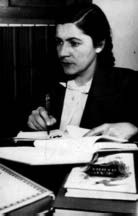 Mirvarid
Dilbazi's first poem, "Women's Emancipation," was published Mirvarid
Dilbazi's first poem, "Women's Emancipation," was published
 in
1927. Her first book, "Our Voice," followed in 1934.
Since then, she has written numerous poems and children's books.
Dilbazi has also translated works by writers such as Pushkin,
Khagani and Nizami. In 1979, she was named "People's Poet
of Azerbaijan". President Aliyev awarded her with the "Istiglal"
(Independence) Order in 1998. For this issue, we asked Dilbazi
to explain how women in Azerbaijan have been affected and transformed
by the changes of the 20th century. in
1927. Her first book, "Our Voice," followed in 1934.
Since then, she has written numerous poems and children's books.
Dilbazi has also translated works by writers such as Pushkin,
Khagani and Nizami. In 1979, she was named "People's Poet
of Azerbaijan". President Aliyev awarded her with the "Istiglal"
(Independence) Order in 1998. For this issue, we asked Dilbazi
to explain how women in Azerbaijan have been affected and transformed
by the changes of the 20th century.
When I reflect
back on this century, the first thing that comes to mind is why
when a child is born, does he enter the world crying? Is it because
he foresees the troubles he'll face in the future? Is that why
he cries? I entered this world crying, and I've spent my whole
life shedding bitter tears. I've witnessed so many troubles.
I witnessed Stalin's Repression of 1937, the tragic losses of
World War II, and now I'm witnessing this Armenia-Azerbaijan
conflict. I wish no one had to go through all of the troubles
that I've experienced.
Russian Czar Nicholas II was overthrown when I was a small child
[1917]. Then a period began that was called "Years of Freedom."
But to tell you the truth, that freedom was more like a taste
of anarchy-people did just as they wished without worrying about
being held accountable.
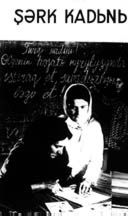  Then
the Musavat government was created [1918-1920]. We were happy
because finally we were beginning to establish our own government-our
own independent state. But our happiness was short-lived. The
Bolsheviks came [1920] and established their government in Baku
and left us under the Soviet oppression for more than 70 years
[1920-1991]. Then
the Musavat government was created [1918-1920]. We were happy
because finally we were beginning to establish our own government-our
own independent state. But our happiness was short-lived. The
Bolsheviks came [1920] and established their government in Baku
and left us under the Soviet oppression for more than 70 years
[1920-1991].
I was eight years old when the Soviets established their power
here. I may have been a child, but I was very conscious of the
process that was going on in my country. Even as a child, you
can't be indifferent to the troubles of your Motherland. During
my lifetime, I witnessed the fall of the Soviets just as I had
witnessed the fall of Azerbaijan's first independent government-the
Democratic Republic of Azerbaijan.
A lot of things might have gone differently if we had been able
to save our Republic back then in 1920. At least, the decision-making
process would have been in our own hands, the official language
would always have been Azeri and the alphabet would not have
been changed to Cyrillic against our will.
After the Soviet government established itself in Baku, Nariman
Narimanov, one of its leaders, opened a school in Baku in 1921.
The director was a very noble and educated woman-her name was
Madina Giyasbeyli. Once this lady came to our village of Dashsalahli
which is located in the Gazakh region in northwestern Azerbaijan.
She happened to stay at my grandfather's house. Since my father
had died, we were all living there with my grandfather. My sister
Yagut and I were attending the village school at the time. This
lady liked us very much and took a great interest in our classes.
She loved it when we recited poems to her.
When it was time for her to return to Baku, she asked my grandfather
if she could take us with her so that we could attend her school.
My family consented. So that's how my sister and I came to Baku.
Rights for Women
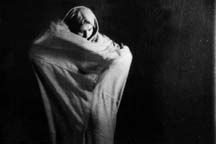 |
Between the 1920s and 1930s, the most burning
issue among the Azerbaijani intelligentsia related to women's
emancipation. This theme became very popular in literature. For
example, there was Jafar Jabbarli's play "Sevil,"1
Mammad Said Ordubadi's "Misty Tabriz,"2 and others.
What was meant by women's emancipation was first of all taking
off the chadors [veils], then women's participation in governmental
affairs and women's literacy.
Women's literacy had been forbidden by the religious leaders.
Girls were not taught to write; a few of them had managed to
learn how to read a bit of the Koran, which was written in the
Arabic script. |
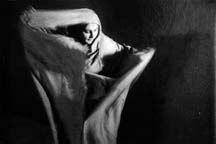 |
Chadors (veils)
have been one of the greatest tragedies of Eastern women. I must
tell you, however, that as far as Azerbaijan was concerned, only
women living in the southern regions near the Iranian border
and some in Baku wore them. Women in the northern regions were
not familiar with them.
For instance, I was born in Gazakh [northwest corner bordering
Georgia] and I never saw a single woman from that region wearing
a chador. Our women weren't familiar with such dress requirements.
In my own family, my mother, sister and I never wore them. Women
in our region wore only silk kerchiefs, not the full-length veil. |
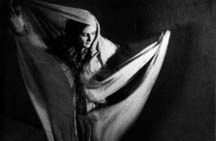 |
I wrote a poem entitled "Mahsati" (1945) about a progressive
poetess of the 12th century. In this poem she is censured for
playing the kamancha,3 for writing and reciting poems and for
opening a school for children.
Shah Sanjar4
demands that she appear at his court and she arrives wearing
a black kerchief. When he asks her why she has arrived in his
court with her face unveiled, she replies: "Let those who
have defects on their faces veil themselves.
I have no defect, so why should I cover my face? We don't have
a tradition of hiding our faces under a veil. A woman's honor
is completely related to her morality, not to what she wears."
|
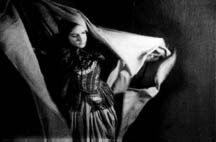 |
Jafar Jabbarli wrote a play called "Sevil", a story
about a progressive woman who exerted her own will. In the episode
where Sevil dramatically removes her chador on stage, many of
the women attending the performance also took off their chadors.
That was in the late 1920s. I would say that the play clearly
contributed to the end of women wearing chadors in Baku. After
"Sevil" finished its run, there were only a few women
still walking around Baku wearing them.
Each family held its own opinion about the chador. Some women
were afraid of their husbands, some of their fathers or brothers.
Some held firmly to traditional religious beliefs advocating
the veil. |
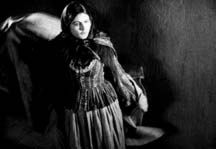 |
I remember that one father killed his daughter in Baku because
she refused to wear the chador. She was buried at a large ceremony,
and the newspapers wrote about her for quite some time. Her father
was arrested.
During this period, both the government and the intelligentsia
encouraged women to take off their veils. There were a lot of
publications devoted to this campaign. Of course, the Soviet
government had its own strategy and self-interests. It opposed
religion (Islam) and as you know, the chador is a matter of religion.
It was only natural that the government would support the campaign
against it. |
I can't explain
the process in great depth, but there was no ultimatum made by
the government. There were no bans on wearing the chador. But
there was a considerable effort made to persuade women to take
them off. In 1928, when I wrote my first poem, it was dedicated
to the issue of women's freedom and emancipation. You could hardly
find a writer back then who didn't write about this subject.
The campaign for women's rights was limited, but it opened many
great opportunities for women. Women began working in governmental
affairs. They became scientists and poets. They started traveling
to foreign countries. Basically, society began changing its attitude
towards the worth of women.
Literacy Campaign
Then
a major campaign was launched against illiteracy. The idea was
to make everyone literate, no matter how old they were. My sister
was a teacher and was involved in this campaign. She went house
to house, registering people, so that no one could be left out.
Then the teachers would go to the homes and instruct the people,
especially women. Schools opened later on. People were very interested
in learning how to read. Later when the schools opened, attendance
was compulsory. If parents didn't send their children to school-both
boys and girls-they were held accountable.
One of the greatest difficulties for our nation has been that
we have changed our alphabet four times in this century. First,
there was the Arabic script that we used for more than a millennium,
then the Latin script was introduced in 1927, then Cyrillic in
1937. Then we reverted to Latin again in 1991 as soon as we gained
our independence.
Changing the alphabet is a violent blow to the cultural heritage
of any nation. It means that the entire legacy of the older generation
cannot be read and accessed by the younger generation. Changing
our alphabet four times this century has resulted in isolating
us from our own thinkers. I guess under such circumstances, I
should consider myself one of the lucky ones to be born in an
era where I was exposed in my youth to all three alphabets-Arabic,
Cyrillic and Latin. But so many people didn't have that chance.
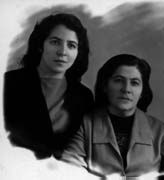 Photo: Dilbazi with her daughter Photo: Dilbazi with her daughter
In 1937 the Soviets made us change our alphabet to Cyrillic.
They feared that if Azerbaijan and the Turkic-speaking countries
of Central Asia used the Latin script just as Turkey did, it
would pose
a gigantic threat to Russia's authority. And so they followed
another strategy-which was very clever in dissipating any consolidation
against them. In Cyrillic, they further complicated the issue
among Turkic speakers by identifying different symbols for the
same vowels in various Turkic languages-Kazakh, Turkmen, Uzbek,
Kyrgyz and Azeri.
For example, Azerbaijan uses a schwa (upside-down "e")
to represent the "a" sound in "fat cat".
Other Turkic-speaking republics had to represent that same sound
with a different symbol. It seems the old adage, "Divide
and conquer" applies to the alphabet as profoundly as it
does to politics.
It's been a great cultural loss within the Turkic world that
during the Soviet period our efforts to read other Turkic Soviet
writers, poets and activists was confounded by a mere few letters
in the alphabet. It's just another reason for shedding tears
in our century.
Footnotes:
1 "Sevil"
was a play by Jafar Jabbarli (1899-1934) dealing with the emancipation
of women. Its story challenged Muslim women to take off their
veils. "Sevil" was made into a movie in 1929 and again
in 1970. It also served as the basis for an opera composed by
Fikrat Amirov in 1953.
2 Mammad Said Ordubadi's "Misty Tabriz" consists
of four volumes written over 15 years (1933-1948). Ordubadi wrote
about the fight for freedom and equality for men and women, which
was carried out by South Azerbaijani people at the beginning
of the 20th century.
3 Kamancha is a traditional Eastern stringed instrument that
is played with a bow.
4 Sanjar Malik Shah was the last sultan of the Saljug State.
He reigned from 1118 until 1157.
Mirvarid Dilbazi was interviewed in July 1999 in her home in
Baku by Aynur Hajiyeva. For samples of Dilbazi's poetry, see this article on
the Web at AZER.com.Photos are from the film, Sevil, 1931. National
Archives.
From Azerbaijan International
(7.3)
Autumn 1999.
© Azerbaijan International 1998. All rights reserved.
Back to Index AI 7.3 (Autumn
99)
AI Home
| Magazine
Choice | Topics
| Store
| Contact
us
|

 Mirvarid
Dilbazi's first poem, "Women's Emancipation," was published
Mirvarid
Dilbazi's first poem, "Women's Emancipation," was published






 Photo: Dilbazi with her daughter
Photo: Dilbazi with her daughter